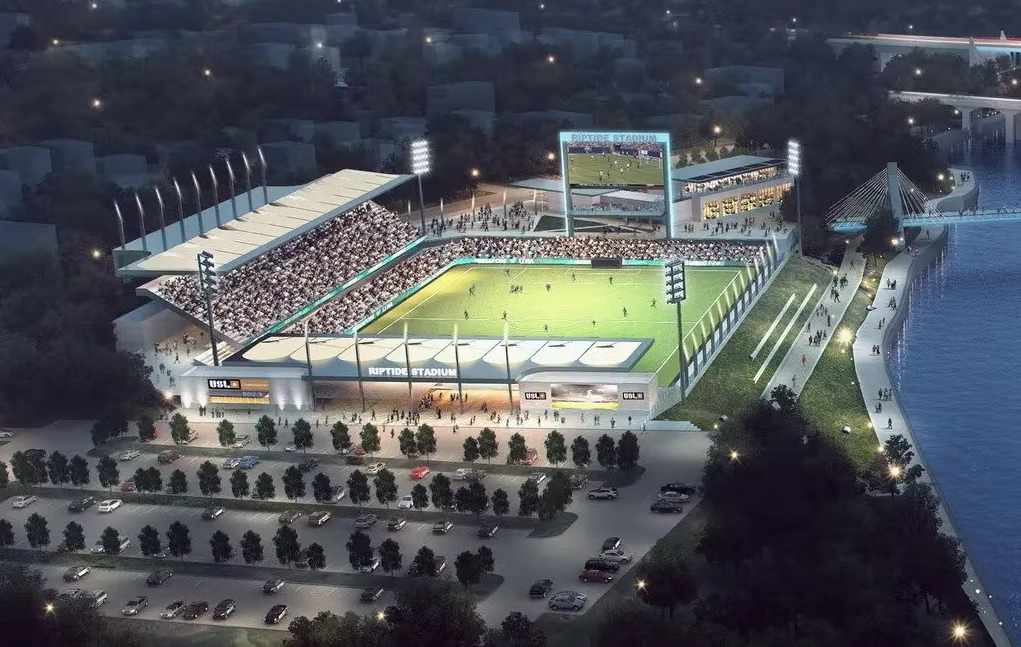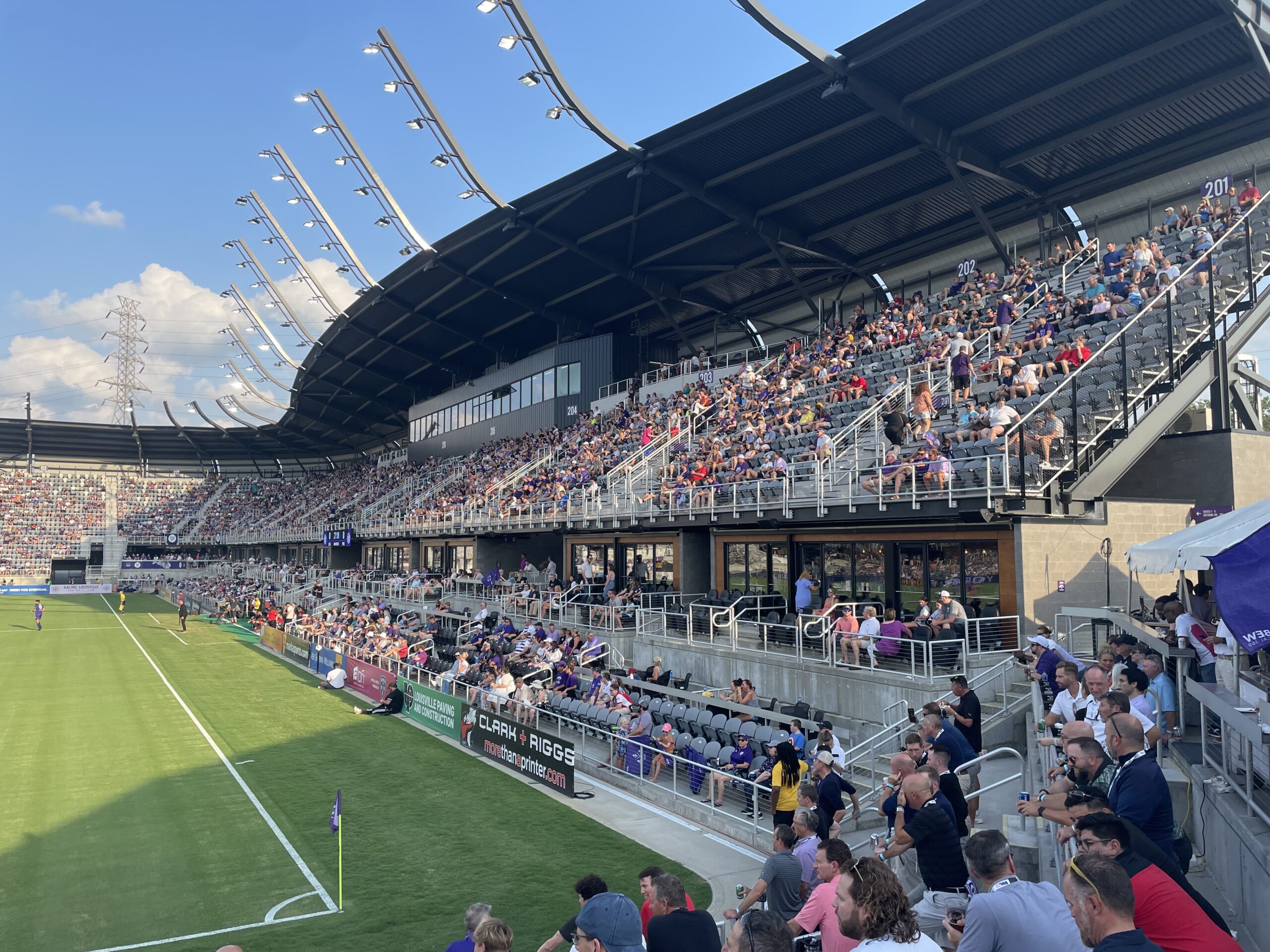How the USL is Building Fan Bases and Communities
Soccer league is developing a wave of new sport-specific venues
Posted On: September 12, 2022 By :Justin Papadakis, just out of college, went on a trip to Los Angeles with his father in 2008 to check out the new L.A. Live downtown entertainment district. The then-Staples Center was shiny and new, surrounded by restaurants that encouraged fans of games to get there early and stay late at the bar. Plans even then included apartment complexes around the area to turn it into a true live, work and play area.
Alec Papadakis, the chief executive officer for the United Soccer League, told his son “this is going to be the future of sports. It’s not just a venue — it’s creating a holistic fan experience both during the game but before and after.”
Those types of projects are what the USL wanted its future strategy to be. Fast forward 14 years later and the USL recently broke ground on the Tidewater Landing project in Pawtucket, Rhode Island; the focal point is the stadium for an expansion team surrounded by housing, retail stores and restaurants on the waterfront.

The Pawtucket stadium, which is set to be completed in 2024 and seat 10,500, is one of 16 soccer-specific stadium projects across the USL, and one of five current stadium projects under construction in the USL Championship and USL League One. Since the start of the 2019 season, 23 of the USL Championship’s 27 venues are new builds.
Growth of the League
Throughout the USL’s stadium boom, there have been several themes. Chief among them is the old real estate mantra: Location, location, location.
“Broadly speaking, we like downtown sites because they’re very accessible to the broad population,” said Justin Papadakis, now the league’s chief operating officer and chief real estate officer. “You have this migration downtown, particularly young millennials and future Gen Zers who want to live the active lifestyle downtown. However, cities are orientated differently when you’re talking about the number of markets that we work on.”
As a result, the league considers modifications based on an expansion or existing team’s demographics. At Weidner Field in Colorado Springs, Colorado, the home of the Switchbacks is in a downtown location that will also be part of an area that includes apartment buildings overlooking one side of the venue. The expansion franchise in Spokane, Washington, will have a downtown stadium of its own near The Podium, a recently opened indoor track-and-field venue. Then there is the project in Rhode Island.
“There was an opportunity to go to a site that is absolutely gorgeous along the river that’s been vacant for 50 years,” Papadakis said. “We could bring a stadium, 500-plus housing units, a real transformational impact, clean up the site and have boats and kayaks so they can utilize the amazing river they have. And so there, we chose to pivot a little bit because of that transformational impact.
“So it really is kind of market dependent. But we look at those variables to see, how can we be accessible and how can we drive transformational impact? And how can we create a destination?”

Another example is Lynn Family Stadium, the centerpiece of transforming what previously was an underutilized area in the Butchertown neighborhood of Louisville, Kentucky. With the now-traditional gathering areas behind each goal and safe standing for supporter groups, Louisville City in short order has gone from a team that played home games at a baseball stadium to one that recently had over 14,500 people for a home game against rival Tampa Bay.
“It’s been a game-changer in a lot of ways,” Louisville Sports Commission Director of Sport Development Greg Fante said. “I think you have to start with the sheer magnitude of what it’s done for our city as a whole to bring high-level professional soccer to the community that did not have access to it before … seven years ago, we weren’t on the soccer map and now we are globally on the soccer map, we’re deeply entrenched and it’s all because of Louisville Soccer Holdings’ vision in willing to put their finances to work and what they’ve built.”
Regardless of location, stadium size is a critical aspect. USL has focused its various projects around the country to be “right-sized” to enhance the fan experience rather than building projects that make fans feel like they’re overwhelmed by the enormity of a venue.
“The size of the stadium speaks to the market’s reception and how many seats you have in there,” said Nick Ragain, president of Colorado Springs Switchbacks FC. “When you’re locating a sports venue there’s more at play than the price involved to get a great location. The number of seats is really the endorsement of the market.”
Commercial Aspects
There is a bottom line to this all, obviously, because as Ragain puts it “the business itself really requires you to be a primary tenant in a venue that you own or control. It doesn’t matter what sport or industry, you have to be the primary tenant or control the venue or your chances of success is slim.”
The league’s building boom also allows for expansion projects to see what has worked well in markets and take little bits and pieces as ideas for their future spaces. USL Spokane President Cindy Chipman — whose team starts in 2024 — said when her group went to fact-finding trips to places such as Colorado Springs and Louisville, they noticed things such as the “amazing art design” at the entrance in Colorado Springs or “the massive scoreboard” in Louisville.
Digital aspects are also key. Having digital screens surrounding the field of play and around the stadium allows for more interactive spots in which league and local sponsors can have their branding showcased.
“At some traditional older stadiums, you have static boards that don’t change over,” Chipman said. “So on a digital screen, you can customize it and it monetizes it in such a different way. Not only for our benefit, which is huge, but mostly for our partners and what they want to do with their advertising. The LED ribbon on the field is extremely important for being able to monetize partnership revenue and make sure that the partners feel that they are a huge part of that fan experience.”
In addition to having stadiums that are sized proportionally for their markets, the fan experience has changed. Papadakis described how the suite options for venues have evolved from small, enclosed boxes that now are more open, larger spaces that suite owners can use for broader business generation with more people in an area.
“If you just have eight people and you only see those eight people, there’s not a lot of business generation. But in a larger open suite where you have a couple hundred people, that’s where you can really underwrite some potential business,” he said. “Which makes the per-ticket cost higher, but also more importantly, it makes the value for the ticket holder so much more.”
Community Aspects
While the stadiums are for soccer, they can be used for much more. Papadakis said part of the USL’s stadium strategy is to program as much as possible beyond just games with ancillary events that can also drive revenue. The USL’s growth in the women’s soccer space can allow the venue’s programming to automatically double even before additional events are a factor.
In Colorado Springs, the Switchbacks have hosted lacrosse, ultimate and a collection of high school championships at Weidner Field; Ragain said the team is looking for a partner to field a professional women’s team as well. The Switchbacks also have an activation area that can be used at games or corporate events on non-gamedays with garage doors as the walls so that depending on the weather, “it’s an indoor catered experience with an outdoor environment,” Ragain said. “It makes it different than other options that other spaces have.”
In Louisville, Lynn Family Stadium hosted a Janet Jackson concert during the weekend of the Kentucky Derby. The destination will also host the 2023 NCAA Division I Men’s College Cup soccer semifinals and championship and is working to get a future NCAA Women’s College Cup to the stadium.
“We never would have been able to host (those events) with the facilities that we previously had,” Fante said. “But this has allowed us to get in the mix for those events. Lynn Family Stadium is serving the local citizens of Louisville in a new way and offering them entertainment opportunities.”
The stadiums also generate new excitement for those franchises working to get off the ground. Chipman said Spokane’s team has already sold 2,000 season ticket deposits — over 40 percent of the stadium’s capacity.
“It’s basically an experiment and a lesson for other communities as well, because are you showing big movie nights? Are you doing some really great things?” Chipman said. “The community feels that it is their living room and that they can do lots of cool things in the stadium in addition to seeing a high level of soccer.”
Posted in: Main Feature, Soccer, Sports Venues